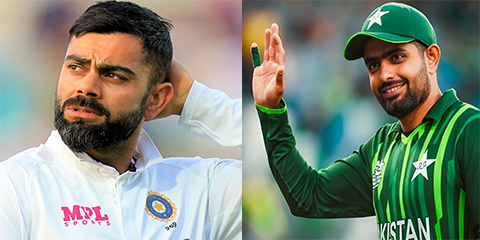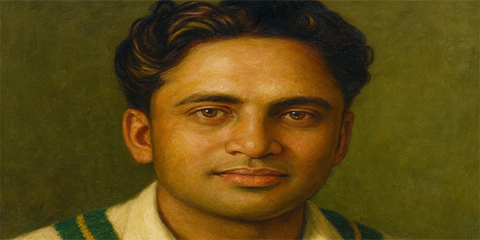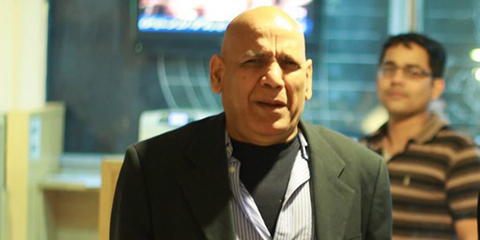Kohli and Babar: Masters of cricket battling their inner demons
JournalismPakistan.com | Published last year | Dr. Nauman Niaz (TI)
Join our WhatsApp channel
ISLAMABAD— In cricket, when top players play, it’s like theatrics where the mind and body relate with skill and intent. For players like Babar Azam and Virat Kohli, whose careers have been characterised by an almost romantic consistency, a run of low scores is not just a statistical aberration, it is a fracture in their internal oeuvre. This disruption strikes at the core of their identities.
Struggles Beyond Technique
To the outsider, it is tempting to attribute their struggles to externalities: a sudden susceptibility to a specific delivery, the quality of bowlers, or even a regrettable streak of luck. But for those who understand the game with all its subtilties and intricacies, the malaise runs deeper. It is not the bowler’s cunning but the batter's internal discord that often proves their undoing.
Virat Kohli: A Test of Equilibrium
For Kohli, the issue may stem from an overreaction to failure, a primal, human response that manifests in the form of visible frustration, intensified focus, and an overcompensation of effort. The elegant fluidity of his game, once so instinctive, begins to stiffen under the burden of expectation. Every dot ball becomes a test of resolve, every dismissal an existential crisis. In these moments, he loses the equilibrium that once made him impervious. The over-reliance on technical tinkering, the burden of self-imposed perfectionism, and a perceived need to answer critics all serve to dilute his natural brilliance.
Babar Azam: The Quiet Struggle
Babar’s predicament, by contrast, is more subdued but equally corrosive. His failures are marked not by visible angst but by a quiet implosion, a gradual erosion of self-belief. He appears trapped within his own high standards, weighed down by the colossal expectations of his nation. There is a haunting irony in his plight: the very consistency that defined him now shackles him, as though the bat feels heavier with every outing, the crease more constricting. The failure is not just on the scoreboard; it is in the subtle shifts of body language, the hesitancy in footwork, the reluctance to take risks, instead of push forward, a side sway or parallel movements.
The Burden of Prolonged Excellence
Both batsmen of the highest caliber, Kohli for sure is a much more acclaimed, celebrated and with a bigger persona and a huge resume face a battle not against bowlers but against their own psyches. They are grappling with the inevitable fatigue of prolonged excellence, mental saturation innate endless cycles of performance, scrutiny, and reinvention. Cricket, after all, is a game of inexorable repetition, and even the most awe-inspiring talent cannot escape the dulling effects of monotony.
Collateral Challenges of Modern Cricket
Compounding their struggles are collateral factors: the isolation of bio-bubbles (during the Covid-19 pandemic), the uncompromising travel schedules, and the unrelenting spotlight of social media. The modern cricketer, unlike their predecessors, exists in a state of near-permanent exposure, where every misstep is magnified, every critique amplified. For players of their stature, failure is not a private affair but a public dissection, a realm of judgment that spares no mercy.
Paths to Renewal
Yet, within this turbulence lies the possibility of renewal. To emerge from such troughs, they must first resolve their inner chaos. Kohli, for instance, must relearn the art of detachment, the ability to treat each ball as a new challenge, free of the baggage of the previous delivery. He must trust the process rather than obsess over outcomes, rediscovering the joy of batting that first endeared him to the sport.
Babar, on the other hand, must reclaim his centre of gravity, not just in the technical sense but in the metaphysical one. He needs to realign with his purpose, to remember that cricket is not just an exercise in run-making but a celebration of mastery and resilience. The answer lies not in radical overhauls but in subtle recalibrations: the return to basics, adherence to mindfulness, the willingness to let go of fear.
Crucially, both players must accept failure not as a verdict but as a springboard. It is in these moments of perceived defeat that the seeds of greatness are strewn. For in cricket, as both are familiar, the true measure of a player is not in their statistics but in their capacity to rise, to adapt, and to endure. In the end, the low scores, the mental battles, and the existential doubts are but momentary, or temporary on the vast panorama of their careers, a reminder that even the brightest stars must sometimes blur before they shine anew.
The Spotlight’s Dual Nature
To exist under the perpetual glare of the spotlight is to inhabit a space where one's identity becomes a public construct, an amalgamation of expectations, narratives, and mythologies spun by millions. For Virat Kohli and Babar Azam, the spotlight is not only a metaphorical realm, it is an unrelenting force that magnifies their triumphs, exposes their flaws, and reduces their humanity to a series of numbers and performances. To thrive under such scrutiny demands a phenomenal module of resilience, where the mental and emotional bandwidth required far exceeds that of the average individual.
This module begins with an almost paradoxical dyad: the capacity to draw energy from adulation while remaining impervious to its seductions. Kohli, with his fiery persona, has often received the adulation with a swagger. The spotlight, for him, has been a source of fuel, a mirror reflecting his larger-than-life presence on the field. Yet, when failures intrude, low scores, technical frailties, and prolonged slumps, it is this very spotlight that turns unforgiving. His reaction becomes visceral, an almost theatrical display of his internal struggle. Kohli's overreactions, visible gestures of frustration, restless tinkering with his technique, suggest a mind caught in the tempest of self-doubt, grappling with the incongruence between expectation and reality.
Babar Azam, in contrast, navigates the spotlight with a quieter disposition, his demeanor exuding calm even in the face of adversity. Yet, beneath the surface lies a different kind of turmoil. His reaction to failure is not one of overt confrontation but of silent implosion. Babar internalizes his struggles, carrying the weight of an entire nation’s hopes on his broad shoulders. His technical vulnerabilities, hesitancy in movement, lapses in judgment are not only slipups in skill but manifestations of an inner struggle to reconcile his human part with the pedestal he has been placed upon.
The phenomenal module that sustains these players is not static; it evolves through success and failure. It demands an extraordinary capacity for self-reflection, a willingness to accept vulnerability, and the courage to confront one's fears. Both Kohli and Babar are products of systems that exalt their achievements but often fail to prepare them for the inevitability of decline. The spotlight, after all, does not blurry in failure; it sharpens, exposing every crevice in their armour, every unguarded moment of doubt.
For Kohli, the challenge lies in reclaiming his internal equilibrium. His vulnerability in low scores stems not from a lack of skill but from a disruption of rhythm, a loss of the instinctive flow that once made his batting seem inevitable. To regain his footing, he must relinquish his obsession with perfection, and rediscover the joy of the game that once defined him. The spotlight, instead of a source of pressure, must become a backdrop, secondary to his primary relationship with the bat.
Babar's trajectory is different but no less arduous. He must learn to balance the humility that defines him with the assertion that greatness demands. His technical adjustments must be accompanied by an emotional recalibration, a recognition that failure does not diminish his worth but adds texture to his career. To step out of the shadows of his vulnerabilities, he must accept them as part of his narrative, finding strength in his resilience.
The spotlight, ultimately, is both a privilege and a burden. For Kohli and Babar, it amplifies their triumphs but also magnifies their struggles, forcing them to confront not only the expectations of the world but the fragilities within themselves. It takes a phenomenal module of mental agility, emotional endurance, and spiritual anchoring to navigate this space, to transform failure into a stepping stone rather than a stumbling block. And in this transformation lies the essence of their humanity, a reminder that even under the brightest lights, they are, above all, human beings striving to excel their limitations.
Criticising Virat Kohli, a cricketer of legendary merit, his career illumed by incomparable accomplishments, seems a discourse misplaced, even futile. His deeds in cricket outdo the realm of records and statistics; they resonate as an authentication to human will and the quest of excellence under inexorable scrutiny.
Kohli: The Captain and the Run Machine
In the purview of Test cricket, Kohli’s legacy gleams with 40 wins in 68 matches as captain, a record that speaks of tactical brilliance and a steadfast spirit. As a batsman, he scaled heights that few have dared to dream of, recording four double centuries in consecutive years, an astounding achievement that underscores not only talent but a resolute work ethic. In One Day Internationals, Kohli stands unsurpassed, a leviathan, the real behemoth with 50 centuries, including 27 while chasing, a format where the margin for error is unforgiving. His ability to anchor innings with serene composure or dismantle attacks with audacious flair defines the duality of his genius.
Kohli’s milestones unwrap like a masterful opus: the fastest to 8,000 runs in 175 innings, 9,000 in 194, 10,000 in 205, and so forth—each achievement bearing witness to his inexorable trudge against the ticking clock of sporting mortality. In the format of ephemeral moments, T20 Internationals, Kohli attained a career-best average of 48.69, a numerical emblem of his adeptness amid chaos. The fastest to 4,000 runs in only 107 innings, he has averred his place as an architect of the modern game, orchestrating performances that defy logic yet remain rooted in his conviction.
His exploits in the Indian Premier League extend his mythology further, with 8,004 runs, the most in the league’s history, including a staggering 973 runs in the 2016 season alone. To share the crease with the likes of AB de Villiers and Chris Gayle is a privilege; to transcend and create history alongside them is an affirmation of greatness.
Kohli’s accolades are no less profound, each an ode to his ceaseless endeavor. The Arjuna Award in 2013 and the Padma Shri in 2017 honor his contribution to Indian sport, while the Major Dhyan Chand Khel Ratna in 2018 celebrates him as a pharos of national pride. His decade-defining prowess was acknowledged with the ICC Men’s Cricketer of the Decade (2011–2020), alongside a gauntlet of other laurels that place him among the immortals of the game.
Yet, beneath this imposing edifice of success lies a man who has sustained the indefatigable glare of expectation, the burden of adulation, and the ferocity of criticism. It is in moments of faltering that Kohli’s resilience has shone most luminously. His career is a spread splattered with shades of triumph and struggle, evoking not only admiration but reflection.
To critique Kohli is to misunderstand the enormity of his impact based on determination, skill, and an unbending desire to excel the ordinary. His legacy is not only the story of a cricketer but an epic of his endeavour, a narrative that, like all great art, defies the confines of critique to dwell in the realm of timeless reverence.
Babar: A Modern Icon of Pakistani Cricket
To reproach Babar Azam, a quintessence, an architype of modern cricketing brilliance, is to fail to grasp the solemn dimensions of his career. This young achiever, shaped amidst the fervent adoration and challenging expectations of a cricket-obsessed nation, and is already part of Pakistan cricket’s folklore.
Babar’s laurels are as numerous as they are illustrious. From being named in the ICC Men’s ODI Team of the Year in 2017 to earning the PCB’s ODI Cricketer of the Year the same year, his ascent has been nothing short of meteoric. In 2018, he was crowned the PCB’s T20 International Player of the Year, a tribute to his versatility across formats. The accolades continued: ICC Men’s ODI Team of the Year in 2019, Player of the Tournament in the Pakistan Super League 2020, and the ICC Men’s ODI Cricketer of the Year in 2021.
He was anointed captain of the ICC Men’s T20 International Team of the Year in 2021, the ICC Men’s ODI Team of the Year in 2021, and even led the ICC Men’s T20 World Cup Team of the Tournament that very year. Not only content with these triumphs, he picked the PCB’s ODI Cricketer of the Year award in 2021 and was also the ICC Cricketer of the Year in 2022.
Such is the measure of his excellence that at the tender age of 28, Babar was conferred Pakistan’s third-highest civilian honour, the Sitara-i-Imtiaz, becoming the youngest cricketer to receive this distinction. Yet, the current climate surrounding Babar is marked by lamentations, rebukes, and undue castigation, a narrative that fails to appreciate the burden. To bat under the unforgiving glare of both adulation and expectation is an ordeal only a chosen few endure. Each innings is dissected, each failure magnified, and the very humanity of the cricketer is often overlooked.
In Babar Azam, we witness the archetype of the modern cricketer, an artist and a gladiator, grappling with the tempest of criticism while striving to uphold his artistry. His career is not just about runs and records; it is a reflective meditation on resilience, poise under pressure, and the quest of excellence amidst ceaseless inquiry. To judge him solely by transient failures is to overlook the timeless contributions of a cricketer who, like all great artisans, shapes his legacy not in moments but across the continuum of time. For Babar Azam, the career is far from over; it is a tale still recounting, still resounding on cricket’s landscape.
The psychology and brain physiology of extraordinary sportsmen, those who operate at the acme of human performance, have become a fascinating area of study in neuroscience and sports psychology. These athletes, often hailed as supernatural due to their brilliance and consistency under pressure, experience unique cognitive, hormonal, and emotional dynamics during play.
The Role of Dopamine and Cortisol Regulation
Here are some exclusive insights into the mechanisms that define their extraordinary performance and the challenges they face. Now let’s get into the scientific inquiry. World-class athletes often exhibit heightened dopamine release during high-stakes moments. This neurotransmitter is crucial for motivation and reward processing. The anticipation of success or achieving a goal enhances their focus, making them thrive in situations where others falter. While cortisol, the stress hormone, typically spikes under pressure, elite athletes demonstrate remarkable regulation. Their brains appear to downregulate excessive cortisol, preventing the impairments in decision-making and motor skills that stress can induce.
Endorphins and the Flow State
During moments of peak performance, endorphins flood the brain, inducing a sense of euphoria and pain resistance. This contributes to the ‘flow state,’ where actions feel effortless and time perception alters. During intense competition, these hormones heighten alertness and energy. However, world-class athletes maintain a delicate balance, enough adrenaline to enhance reaction times without tipping into over-arousal, which could cause errors.
Hormonal Influence on Performance
High levels of testosterone, often associated with aggression and competitive drive, are common in elite sportsmen. It enhances confidence and dominance but can also lead to over-aggression or confrontational attitudes if unchecked. In team sports, oxytocin fosters trust and social bonding. Athletes with strong interpersonal connections often exhibit higher levels of this hormone, improving cohesion and performance.
Neuroplasticity and Motor Cortex Activation
Supernatural athletes display remarkable neuroplasticity, allowing their brains to adapt to changing circumstances with incredible speed. This underpins their ability to learn new skills, refine techniques, and recover from setbacks. The motor cortex in these athletes is hyperactive during play, facilitating precise movements and coordination. This is particularly evident in sports requiring fine motor skills, such as cricket batting or tennis serves.
Prefrontal Cortex and Decision-Making
While the prefrontal cortex governs rational decision-making, elite athletes can ‘switch off’ its overactivity during performance, preventing overthinking and hesitation.
Emotional Intelligence and Resilience
The provocations that elite sportsmen face often exploit their competitive nature. For example, sledging or taunts aim to disrupt their focus. However, athletes with high emotional intelligence and self-regulation neutralize such tactics effectively. Over time, the relentless pursuit of excellence can lead to mental saturation, where motivation wanes despite continued success. This stems from a diminished reward response in the brain after prolonged exposure to high-pressure scenarios.
The Mental Challenges of Performance
Many brilliant athletes tie their self-worth to performance. A slump can trigger identity conflicts, amplifying stress and creating a vicious cycle of self-doubt. Techniques like mindfulness improve focus and reduce stress.
By training their brains to remain present, athletes avoid distractions and recover quickly from errors. Mentally rehearsing scenarios activates the same neural pathways as actual performance. This primes their brains for success and builds confidence in challenging situations. Addressing negative thought patterns helps these athletes regain composure after failures and prevents emotional spirals that can erode performance.
The Impact of Chronic Overtraining
Chronic overtraining disrupts hormonal cycles, leading to exhaustion and reduced performance. Balancing rest and activity is essential to sustaining brilliance. The focus required for world-class performance often comes at the cost of personal relationships, affecting oxytocin levels and overall well-being. Prolonged exposure to pressure can cause hyperactivity in the amygdala (the brain's fear center), leading to anxiety and stress disorders if unmanaged.
Sustaining Excellence
The phenomenal capabilities of supernatural athletes arise from an intricate interplay of brain chemistry, hormonal regulation, and psychological resilience. However, brilliance comes with its challenges, requiring a proactive approach to mental health, emotional regulation, and physiological balance. By leveraging advancements in sports psychology and neuroscience, these athletes can sustain their performance while mitigating the toll that such excellence demands. Virat Kohli is surely a supreme athlete and his shouldering Sam Konstas seems logically explainable, though not by any standards defendable.
Dr. Nauman Niaz is a civil award winner (Tamagha-i-Imtiaz) in Sports Broadcasting and Journalism and a regular cricket correspondent, having covered 54 tours and three ICC World Cups. He has written over 3,500 articles, authored 14 books, and is the official historian of Pakistan cricket (Fluctuating Fortunes IV Volumes—2005). His signature show, Game On Hai, has received the highest ratings and acclaim.

























